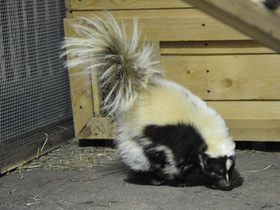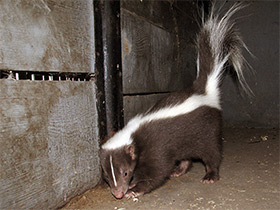The striped skunk (Mephitis mephitis)
Striped skunk видео
The striped skunk (Mephitis mephitis) is a skunk of the genus Mephitis that occurs across much of North America, including southern Canada, the United States, and northern Mexico. It is currently listed as least concern by the IUCN on account of its wide range and ability to adapt to human-modified environments.
Striped skunks are polygamous omnivores with few natural predators, save for birds of prey. Like all skunks, they possess highly developed musk-filled scent glands to ward off predators. They have a long history of association with humans, having been trapped and captively bred for their fur and kept as pets. The striped skunk is one of the most recognizable of North America's animals, and is a popular figure in cartoons and children's books.
Taxonomy
The striped skunk was first formally named by Johann Christian Daniel von Schreber as Viverra mephitis. The type locality is in eastern Canada.
Evolution and subspecies
The earliest fossil finds attributable to Mephitis were found in the Broadwater site in Nebraska, dating back to the early Pleistocene less than 1.8 million years ago. By the late Pleistocene (70,000–14,500 years ago), the striped skunk was widely distributed throughout the southern United States, and it expanded northwards and westwards by the Holocene (10,000–4,500 years ago) following the retreat of the Wisconsin glacier.
Phylogenetic analyses of the species' cytochrome b gene and microsatellite data in 2012 indicated that there are four phylogroups of striped skunk. The first emerged from the Texas-Mexico region during the Rancholabrean before the Illinoian glaciation and colonized the southeastern United States. The second, still originating in the Texas-Mexico region, expanded westwards to the Rocky Mountains during the Illinoian glacial period. Two subsequent subclades were formed during the Sangamonian interglacial on either side of the Sierra Nevada. The subclade that colonized the Great Basin later expanded eastwards across the northern Rocky Mountains during the Holocene, recolonising the Great Plains and making contact with the southern phylogroup. A similar, but less significant, secondary contact occurred when the same subclade intermingled with members of the eastern phylogroup east of the Mississippi river.
Thirteen subspecies of the striped skunk are generally recognized:
Canada skunk (Mephitis mephitis mephitis) - A large subspecies with a short and slender tail and a mixed black and white coat with constant markings. Eastern Canada; Nova Scotia, Quebec, and northern Ontario.
Synonyms: M. americana (Desmarest, 1818), chinche (Fischer, 1829), mephitica (Saw, 1792), vulgaris (F. Cuvier, 1842);
Illinois skunk (Mephitis mephitis avia) - Similar to M. m. mesomelas, but with a slightly larger skull. Prairie region of Illinois, western Indiana, and eastern Iowa. Synonyms: newtonensis Brown, 1908
Florida skunk (Mephitis mephitis elongata) - A medium-sized subspecies with a very long tail. The white markings are usually very broad. Florida to North Carolina, and in the mountains to West Virginia; west on the Gulf coast to the Mississippi River.
Arizona skunk (Mephitis mephitis estor) - A small subspecies resembling M. m. varians, but with a shorter tail and smaller skull. The white markings are particularly broad along the back and tail. Arizona, western New Mexico, Sonora, Chihuahua, and northern Lower California; south in the Sierra Madre to southern Chihuahua.
Southern California skunk (Mephitis mephitis holzneri) - Similar to M. m. occidentalis, but smaller. Southern California, from vicinity of Monterey Bay south into Lower California; east to the Sierra Nevada and San Bernardino Range.
Northern plains skunk (Mephitis mephitis hudsonica) - A very large subspecies with a heavily furred, medium-sized tail. Western Canada, from Manitoba to British Columbia; south in the United States to Colorado, Nebraska, and Minnesota. Synonyms: americana (Lesson, 1865), chinga (Tiedemann, 1808), minnesotoe (Brass, 1911).
Great Basin skunk (Mephitis mephitis major) - Probably the largest subspecies, similar to M. m. occidentalis, but with longer hind feet and a heavier skull. Eastern Oregon, northern California, and Nevada; east to the Wasatch Mountains in Utah.
Louisiana skunk (Mephitis mephitis mesomelas) - A very small, short-tailed subspecies. West side of Mississippi Valley from southern Louisiana to Missouri; westward along the coast of Texas to Matagorda Island; and up the Red River Valley as far at least as Wichita Falls. Synonyms: mesomeles (Gerrard, 1862), scrutator (Bangs, 1896).
Eastern skunk (Mephitis mephitis nigra) - A medium-sized subspecies, with a longer tail than that of M. m. mephitis. New England and Middle Atlantic States; south to Virginia; west to Indiana. Synonyms: bivirgata (C. E. H. Smith, 1839), dentata (Brass, 1911), fetidissima (Boitard, 1842), frontata (Coues, 1875), olida (Boitard, 1842), putida (Boitard, 1842).
Cascade Mountains skunk (Mephitis mephitis notata) - Similar to M. m. occidentalis, but with a shorter tail, heavier skull, and narrower stripes. Southern Washington and northern Oregon, east of the Cascade Mountains.
California skunk (Mephitis mephitis occidentalis) - A large subspecies resembling M. m. hudsonica, but with a longer tail and narrower skull. Northern and central California, from the vicinity of Monterey Bay northward, west of the Sierra and Cascades, to the Willamette Valley, Oregon. Synonyms: notata (Howell, 1901), platyrhina (Howell, 1901).
Puget Sound skunk (Mephitis mephitis spissigrada) - Similar to M. m. occidentalis, but with a shorter tail and more white on the body and tail. Shores of Puget Sound and coastal region of Washington and northern Oregon. Synonyms: foetulenta (Elliot, 1899).
Texas long-tailed skunk (Mephitis mephitis varians) - A large, very long-tailed subspecies whose markings closely approach those of M. m. hudsonica. Southern and western Texas, eastern New Mexico, and adjacent parts of Mexico; north into Oklahoma, Colorado, Kansas, and Nebraska. Synonyms: texana (Low, 1879).
Vernacular names
The English word skunk has two root words of Algonquian and Iroquoian origin, specifically seganku (Abenaki) and scangaresse (Huron). The Cree and Ojibwe word shee-gawk is the root word for Chicago, which means 'skunk-land'. Alternative English names for the striped skunk include common skunk, Hudsonian skunk, northern skunk, black-tailed skunk and prairie polecat. The latter name was originally used by English settlers, who noted the animal's similarity to the European polecat. This association likely resulted in the striped skunk's subsequent unfavorable reputation as a poultry thief, despite it being a much less destructive animal than the true polecat. The name "Alaska sable" was employed by furriers during the late 19th century.
Appearance and peculiarities
Mephitis mephitis is a species of carnivorous mammal of the family Mephitidae.
Mephitis mephitis is a medium-sized animal: its body length is 28-38 cm, its tail is 17-30 cm and it weighs between 1.2 and 5.3 kg. It has short walking legs with long, weakly curved claws designed for digging, a long, fluffy tail and short ears with a broad base and rounded tips.
The coat of Mephitis mephitis is very dense, but coarse, coloured in black and white: against an overall dark background, broad white stripes can be distinguished, starting on the head and running down the spine to a tail striped in black and white (interestingly, the details of the colouring are individual for each specimen). Such bright, contrasting colouring serves as a warning to potential predators.
Under the tail of Mephitis mephitis are peculiar stink glands that secrete an oily liquid with a foul, persistent odour, similar to that of rotten eggs. If Mephitis mephitis is disturbed, it first arches its back, raises its tail and rattles its teeth as a warning. If this does not work, the beast turns its back to the enemy, places its tail on its back and by contracting its sphincters throws the secret of its anal glands at it, accurately hitting its target at a distance of up to 6 metres. Mephitis mephitis usually marks its eyes and, if successful, the opponent feels a strong burning sensation and may even be temporarily blinded. In areas where Mephitis mephitis lives permanently, it is only attacked by young, inexperienced mammalian predators, and its main enemies are birds of prey.
Distribution and nutrition
Mephitis mephitis is possibly the most widespread skunk species in North America. It ranges from Canada to the northern states of Mexico. Mephitis mephitis is ubiquitous in North America, from southern Canada to northern Mexico, with only Alaska and Hawaii missing. Skunks lead a solitary lifestyle for most of the year, swimming well but not climbing trees well. These omnivorous predators hunt at dusk or at night. Up to 70% of their diet consists of insects; they also eat small mammals (voles, hamsters, rabbits), bird eggs and chicks, fish, reptiles and plant foods: grass, leaves, shoots, fruits, grains and nuts, as well as carrion. In autumn, skunks put on weight and become very fat.
In late October or early November, they begin to gather dry grass and leaves for their winter nest, and hibernate in early December. Their winter shelters are burrows and any dry, isolated place. Females usually gather in winter roosts in groups of up to 6 individuals with young; sometimes a single male winters with them, but most often males occupy separate roosts. Females and young rarely awaken before the end of March, but adult males may be active during winter thaws.
Reproduction
Male Mephitis mephitis are polygynous and mate with several females. The average gestation period is 63 days. A litter may contain 2-10, but usually 5-6 offspring. Newborns are born blind and helpless, and their eyes open at two weeks of age. At one month of age the cubs are able to adopt a defensive posture by raising their tails. The female feeds them with milk until they are 6-7 weeks old, when the young skunks leave the den and follow their mother in search of food. They spend the first winter with her and by the following spring they are fully independent. In the wild, Mephitis mephitis live only 2-3 years, but in captivity they can live up to 5 years.
Predation
Because of its formidable defensive capability, the striped skunk has few natural enemies. Mammalian predators typically avoid skunks, unless they are starving. Such predators include cougars, coyotes, bobcats, badgers, and red and gray foxes. Predatory birds, including golden and bald eagles, and great horned owls tend to have greater success in hunting skunks, though they still risk being blinded by their prey's musk.
Disease
The striped skunk is one of the major carriers of the rabies virus, second only to raccoons in the US where skunks are 25% of annual cases. Skunks are the primary hosts in the north- and south-central United States as well as in Canada. Cases of rabies in this species are generally epizootic and recurrent. They are also host for the canine parvovirus and may also suffer from leptospirosis. A striped skunk from Texas was found to be a host of an intestinal acanthocephalan worm, Pachysentis canicola.

















































